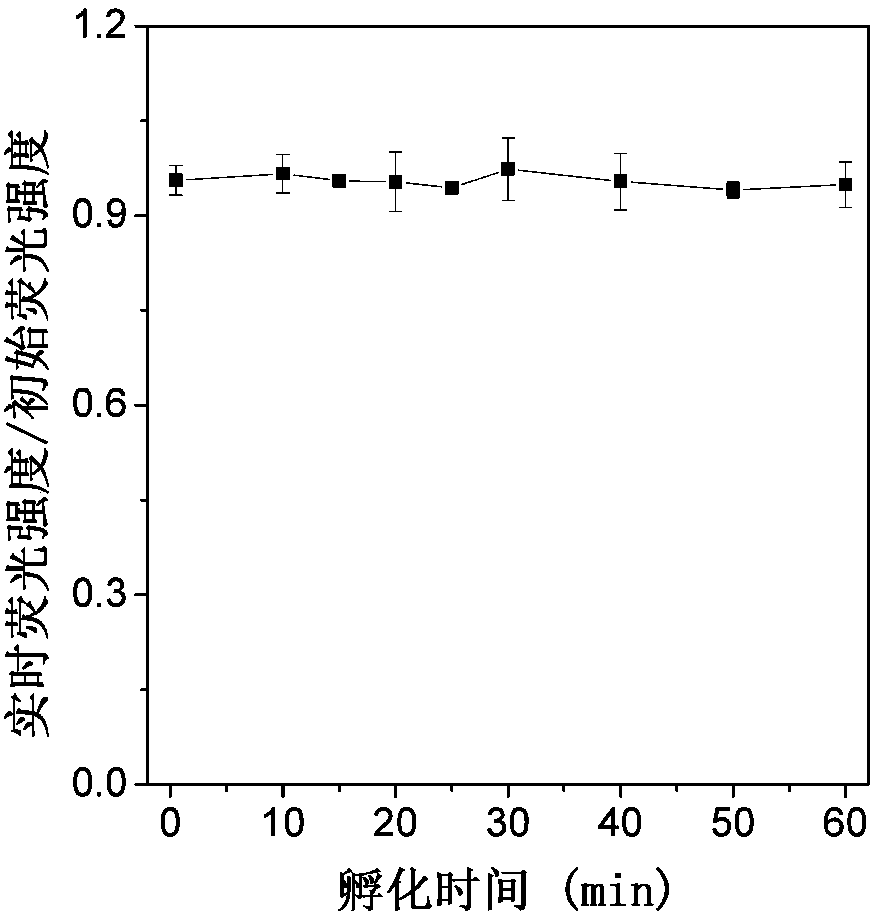Carboxylesterase fluorescent probe as well as preparation method and application thereof
A carboxylesterase and fluorescent probe technology, applied in the field of carboxylesterase fluorescent probes and their preparation, can solve the problems of shallow tissue penetration depth and imaging depth, short excitation wavelength, cell photodamage, etc. Penetration depth and imaging depth, short response time, light damage reduction effect
- Summary
- Abstract
- Description
- Claims
- Application Information
AI Technical Summary
Problems solved by technology
Method used
Image
Examples
preparation example Construction
[0041] The present invention provides the preparation method of carboxylesterase fluorescent probe described in above-mentioned technical scheme, comprises the following steps:
[0042] (1) A compound having a structure shown in formula II, acetyl chloride, an alkaline reagent and an organic solvent are mixed for acetylation reaction to obtain a compound having a structure shown in formula III;
[0043] (2) Mix the compound having the structure shown in formula III with 1,2,3,3-tetramethyl-3H-indole iodide and an organic solvent, and carry out condensation reaction under a protective atmosphere to obtain formula I The carboxylesterase fluorescent probe of the shown structure;
[0044]
[0045] In formula II and formula III, R 1 , R 2 , R 3 and R 4 independently hydrogen, amino, alkyl, alkoxy, alkylamino, aryl, aryloxy or arylamino.
[0046]In the present invention, the compound having the structure shown in formula II, acetyl chloride, alkaline reagent and organic solv...
Embodiment 1
[0061] Carboxylesterase fluorescent probes were prepared according to the following reaction scheme:
[0062]
[0063] (1) Compound 1 (172.2mg, 1mmol), triethylamine (121.4mg, 1.2mmol) and dichloromethane (anhydrous grade) were mixed, and acetyl chloride (94.2mg, 1.2mmol) was mixed at 0°C within 2min Drop into the obtained mixed solution, stir at room temperature to carry out the acetylation reaction, monitor the reaction progress with a TCL plate until the compound 1 disappears completely; wash the obtained acetylated material with saturated saline for 3 times, and dry the obtained organic phase with anhydrous sodium sulfate , was concentrated to a solid by rotary evaporation, and then recrystallized with a mixture of ethyl acetate and petroleum ether (the volume ratio of ethyl acetate and petroleum ether was 1:40) to obtain a white solid.
[0064] The calculated yield is 92%;
[0065] The resulting white solid is characterized, and the specific data are as follows:
[0...
Embodiment 2
[0074] Carboxylesterase probe prepared in embodiment 1 is carried out performance test, specifically as follows:
[0075] Stability determination of the carboxylesterase probe: 20 μL of HCyNAc in DMSO (1 mM) was added to 2 mL of PBS buffer solution (pH 7.4) to obtain a 10 μM HCyNAc solution, and the resulting solution was incubated at 37° C. for different times (10 , 15, 20, 25, 30, 40, 50, 60 min), measure the variation of the fluorescence intensity of the solution with the incubation time. figure 1It is the change diagram of the fluorescence intensity of HCyNAc incubated in PBS buffer solution at 37°C for different time, from figure 1 It can be seen that the fluorescence intensity remains basically unchanged, indicating that the stability of the carboxylesterase probe is better.
[0076] Sensitivity determination of carboxylate enzyme probe to pH: Add 20 μL HCyNAc DMSO solution (1 mM) in 2 mL PBS buffer solution (pH values are respectively 5.0, 5.5, 6.0, 6.5, 7.0, 7.5, 8....
PUM
 Login to View More
Login to View More Abstract
Description
Claims
Application Information
 Login to View More
Login to View More - Generate Ideas
- Intellectual Property
- Life Sciences
- Materials
- Tech Scout
- Unparalleled Data Quality
- Higher Quality Content
- 60% Fewer Hallucinations
Browse by: Latest US Patents, China's latest patents, Technical Efficacy Thesaurus, Application Domain, Technology Topic, Popular Technical Reports.
© 2025 PatSnap. All rights reserved.Legal|Privacy policy|Modern Slavery Act Transparency Statement|Sitemap|About US| Contact US: help@patsnap.com



